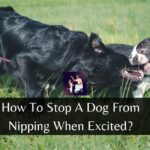Puppies, with their boundless energy and enthusiasm, often express their excitement and affection by jumping on people. While this behavior might seem endearing when they’re small, as they grow, it can become problematic, especially if they jump on children or elderly individuals.
Training a puppy to greet people without jumping is an essential part of raising a well-mannered dog. In this article, we’ll delve into the reasons puppies jump and provide practical solutions to curb this behavior, ensuring safe and polite interactions.
How To Get Puppy To Stop Jumping?
Puppies jump for various reasons, including excitement, seeking attention, or simply because it’s a natural greeting behavior. However, it’s essential to teach them not to jump on people, both for safety reasons and to ensure they’re well-mannered as they grow. Here’s a step-by-step guide to help curb your puppy’s jumping behavior:
Ignore the Jumping
- Non-Reaction: Dogs, especially puppies, crave attention. By reacting to their jumping, even negatively, you’re giving them the attention they seek. Ignoring the behavior sends a clear message that jumping won’t get them what they want.
- Body Language: When turning away from a jumping puppy, keep your arms folded and avoid any verbal interaction. This non-reactive stance reinforces the idea that jumping doesn’t result in attention.
Teach an Incompatible Behavior
- Sit Before Greeting: If your puppy learns to sit before getting attention or treats, they’ll start offering this behavior more frequently. Over time, sitting becomes the default greeting.
- Consistency: Every time you or someone else approaches the puppy, ask for a sit. This consistent expectation reinforces the behavior.
Use Positive Reinforcement
- Immediate Rewards: Dogs live in the moment. To make the connection between staying grounded and the reward, you need to praise or treat them immediately after they display the desired behavior.
- High-Value Treats: Especially in the beginning, using a treat that your puppy particularly loves can make the reward more impactful.
Manage the Environment
- Controlled Greetings: If you’re expecting guests or returning home, having your puppy on a leash gives you control. You can prevent them from jumping up and reward them when they remain calm.
- Use Barriers: Baby gates or playpens can be useful in managing your puppy’s space, especially during high-excitement times, like when guests arrive.
Consistent Training
- Unified Household Rules: If one family member allows jumping while another doesn’t, it can confuse the puppy. Everyone should be consistent in not rewarding jumping.
- Inform Visitors: Let visitors know about your training efforts so they can also ignore jumping and reward calm behavior.
Teach “Off” Command
- Clear Command: The “off” command should be distinct and only used for this purpose. Avoid using multiple terms like “down” or “no jump” interchangeably.
- Practice: Regularly practice the “off” command in controlled environments to reinforce its meaning.
Avoid Encouraging Jumping
- Mindful Play: Games like “jump and catch” can inadvertently encourage jumping behavior. Opt for games that promote calmness or use toys that keep the puppy grounded, like tug toys.
- Avoid Overexcitement: If you come home and immediately shower your puppy with high-energy attention, they’ll likely jump out of excitement. Instead, greet them calmly and reward them when they’re calm.
Socialization and Exercise
- Playdates: Organized play sessions with other well-behaved dogs can teach your puppy appropriate behaviors. They learn a lot from interacting with their peers.
- Mental and Physical Exercise: Activities like puzzle toys, fetch, and obedience training can help tire out your puppy, making them less likely to jump out of sheer energy.
Professional Training
- Structured Learning: Obedience classes provide a structured environment where your puppy can learn basic commands and manners.
- Expert Guidance: Professional trainers can offer specific techniques and insights tailored to your puppy’s behavior.
Patience and Persistence
- Understanding Development: Puppies are energetic and curious. As they mature and with consistent training, many will naturally reduce behaviors like jumping.
- Celebrate Progress: Every time your puppy chooses to sit instead of jump, it’s a step in the right direction. Celebrate these moments and stay persistent in your training efforts.
Addressing jumping behavior requires understanding from the owner’s side. Recognize that your puppy isn’t trying to be defiant; they’re just eager to interact. With patience, consistency, and positive reinforcement, jumping can be effectively managed.
What Age Do Puppies Stop Jumping Up?
Puppies do not “grow out” of jumping up; it is a trait that frequently persists into maturity if not addressed. Puppies leap to welcome or attract attention. Many puppies can learn to meet visitors without jumping by the age of 6-12 months with persistent training.
However, the length of the habit varies from person to person. Effective tactics for reducing jumping include reinforcing calm greetings and teaching alternative behaviors like sitting.
Bottom Line
Teaching a puppy not to jump requires consistency, patience, and positive reinforcement. By understanding that jumping is often a form of attention-seeking or over-excitement, owners can redirect this behavior to more appropriate forms of greeting.
Employing techniques such as turning away, using firm commands, and rewarding calm behavior can make a significant difference. With time and consistent training, your puppy can learn to greet people politely, ensuring a harmonious relationship between your pet and all who come into contact with them.
Read More: Why Do My Puppy Bite So Much?











